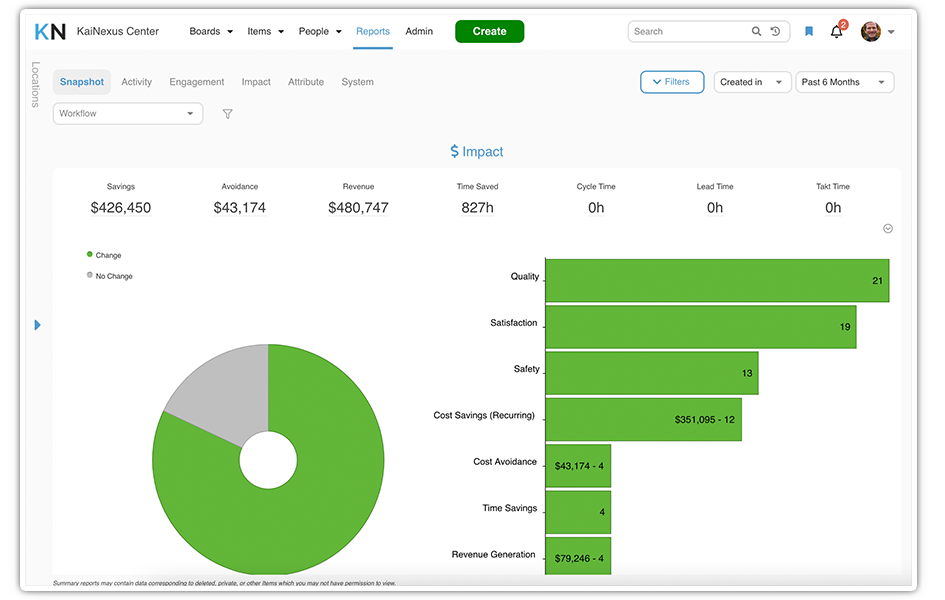 Organizations that successfully instill a culture of continuous improvement constantly outperform the competition, regardless of size or industry. From healthcare to manufacturing and construction, and beyond, the effort and energy put into business process improvement is directly related to measurable results and financial benefits.
Organizations that successfully instill a culture of continuous improvement constantly outperform the competition, regardless of size or industry. From healthcare to manufacturing and construction, and beyond, the effort and energy put into business process improvement is directly related to measurable results and financial benefits.
What Matters Gets Measured, and What Gets Measured Improves
Most organizations have a specific set of performance indicators that they measure constantly. Every company in the world measures revenue, one of the most apparent indicators of a company's health. Customer satisfaction and turnover are additional metrics tracked by organizations of all types. Keeping an eye on HR stats, such as recruiting and retention, is also common.
Tracking these KPIs is essential because it gives leaders the information to adjust and improve organizational processes. When you think about it this way, continuous improvement is an element of every measurement with which senior executives concern themselves. Thus, analyzing, tracking, and talking about improvement efforts is one of the most important things an organization can do to ensure it meets its strategic objectives and outperforms the competition.
See below for an example of an impact and benefits dashboard in our KaiNexus platform:

Why Leaders Doubt Process Improvement Measurements
Most organizations manage business process improvements with a mash-up of productivity tools, including shared documents, physical artifacts, emails, and spreadsheets. This hodge-podge approach is probably familiar.
Kanban boards are a popular management method. Leaders might get email updates when the board is updated. A team member could take photos of the board to preserve it. Some teams schedule tasks in Outlook and track projects in spreadsheets. Often, every department has its own approach. If this sounds familiar and your results are hard to quantify, you are not alone.
The challenge with this decentralized approach to measuring improvement results is that there is no single version of the truth. Spreadsheets are easy to break, emails go unanswered, and physical boards are hard to share. Business process improvement reporting is open to doubt and disbelief without a standard way of measuring positive impact. Leaders who value data tend to discount results and question the effects of improvement entirely.
The Benefits of Calculating the ROI of Improvement
Five important things start to happen when you begin tracking the ROI of business process improvement.
1 - The things you measure get better. When people know that leadership is closely tracking a particular performance measure, they will pay attention and provide extra effort to make sure the trend is positive.
2 - You get clarity around the current and desired state. The health of your improvement culture may be better or worse than you think. Only by understanding exactly where you are can you chart the path forward.
3 - You set and meet better objectives. Collecting benchmark data about improvement work allows you to set realistic, specific, and measurable goals for the future. Then, you can commit without reservation.
4 - Decision-making improves. Data is a critical factor in making good decisions. If you know what is happening within the process you are measuring, you'll learn how and when to act.
5 - You will earn additional resources. Getting leaders to invest in improvement efforts is easy when you can demonstrate a positive return. In addition, providing organized, detailed information about improvement work builds trust.
Activity, Engagement, and Impact Reporting
To develop a reliable, standardized, and meaningful method for measuring business process improvement, it is vital to capture three critical markers - activity, engagement, and impact.
Activity (What)
Tracking activity means understanding what improvement projects are happening and at what scale. This gives you insight into how hard the organization is working to meet its annual goals. The types of activities and targeted processes should align with the strategic direction and the current year's priorities.
Some activity-based metrics to consider are:
Completion Percentage: Not every opportunity for improvement that is submitted will result in a completed improvement project, but you want to know if the ratio of submissions to completions starts to slip.
Improvement Velocity: It is essential to know how many opportunity submissions are coming in and how long it takes them to get through the implementation pipeline. When you increase the velocity of improvement, the financial returns also increase.
Project Status: Visibility into each current improvement project's status helps leaders gauge the culture's health. If improvement is a priority, there will be complete documentation of each effort and very few overdue tasks.
Engagement (Who)
Measuring who is engaged helps you discover if you have an underdeveloped improvement culture, with most of the ROI coming from a few committed individuals, or if you have a robust culture where most team members practice improvement work.
Common engagement measurements include:
Employee Engagement Numbers: This simple stat tells you who is doing what. You can identify at the individual level who needs to be commended for their efforts and who needs help to improve. Trends in the number of engaged individuals indicate the effectiveness of improvement leadership.
Engagement by Role: One thing that sets organizations with a continuous improvement mindset apart from those without is that they expect employees at every level to engage in improvement work. Anyone can submit an opportunity for improvement and work to implement. Looking at engagement by role lets you know if your efforts to create a broad base of participants are working.
Engagement by Location or Team: If one location or functional area is outperforming the others, you can find out what is working well and enlist the help of successful managers to spread it to those who might be struggling.
Impact (Why)
While the first two categories give you the business process improvement information to manage your organization, the impact metric gives you the ammunition to prove ROI and justify continued investment in improvement work.
Keep in mind that alongside financial measures like cost savings and increased revenue, improvement efforts also impact other crucial outcomes, including safety enhancements, sustainability, time savings, and employee satisfaction.
Of course, a single improvement can impact more than one metric. For example, an improvement that increases revenue by adding a new product feature may also affect the satisfaction of existing customers. To give you some benchmarks, our customers have found that:
- 33% of improvements have a financial impact
- 54% of improvements impact quality
- 13% of improvements improve the safety of staff and customers
- 54% of improvements increase staff and customer satisfaction
- 13% of improvements save money, with 80% resulting in recurring annual savings
- 25% of improvements save time
This adds up to about a $25,000 annual impact per person, with 80% of the impact coming from the front lines. This is why a bottom-up, all-hands-on-deck approach to improvement is the fastest path to an impressive ROI.
Continuous business process improvement is essential in today's hyper-competitive era. Whether your processes include helping sick patients get back on their feet, building new housing, educating students, or manufacturing physical products, engaging every individual in improvement is the path to more significant improvement results. A systematic and consistent approach to measuring process improvements is the best way to get everyone excited, keep leadership engaged and overcome any challenges that may arise.




Add a Comment